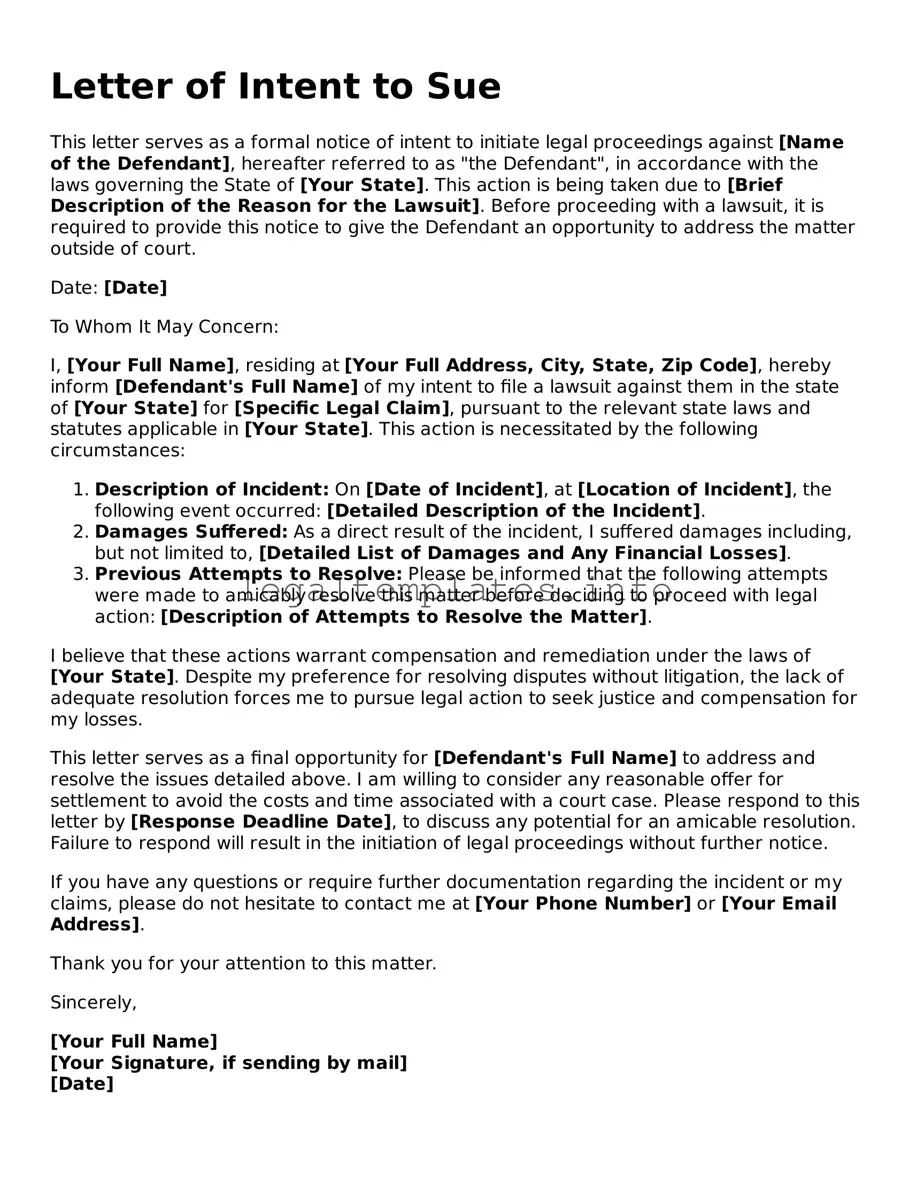A Cease and Desist Letter is quite similar to a Letter of Intent to Sue in that both serve as formal notices. A Cease and Desist Letter, however, is generally used to demand that an individual or entity stop a particular action, potentially violating rights, before legal action is considered. It's a warning that if the behavior in question doesn't cease, further legal action, including a lawsuit, may follow. This document serves as a preliminary step, similar to a Letter of Intent to Sue, which explicitly states the sender's intention to initiate legal proceedings if specific conditions are not met.
A Demand Letter shares similarities with a Letter of Intent to Sue by being a precursor to potential legal action. It outlines a claim, such as an unpaid debt or unfulfilled contract, and requests rectification within a certain timeframe. Unlike the Letter of Intent to Sue, which announces the sender's decision to take legal action, a Demand Letter seeks to resolve the dispute out of court, emphasizing negotiation and settlement as preferred outcomes. Nevertheless, both documents indicate preparedness for legal proceedings if the recipient's response is unsatisfactory.
The Notice of Breach of Contract is closely related to a Letter of Intent to Sue, specifically in cases involving contract disputes. This notice is sent to inform a party that they have failed to fulfill their contractual obligations and provides them with an opportunity to correct the breach. It's similar to a Letter of Intent to Sue in that it often precedes formal legal action and aims to give the recipient a chance to remedy the situation before being taken to court.
Eviction Notices are used by landlords to inform tenants of a breach in the rental agreement, such as unpaid rent or property damage, and to demand correction within a specified period. Similar to a Letter of Intent to Sue, an Eviction Notice can escalate to legal action — in this case, an eviction lawsuit — if the tenant fails to comply within the given timeframe. Both documents serve the purpose of officially communicating grievances and the intention to pursue legal remedies if necessary.
A Notice to Quit, much like an Eviction Notice, is employed by landlords but specifically demands that the tenant vacate the premises by a certain date due to violations of the lease or rental agreement. It parallels the Letter of Intent to Sue by serving as a formal warning that legal action (eviction) will be the next step if the tenant does not comply with the notice's demands. Both documents are used to escalate a dispute towards legal resolution when prior negotiations have failed.
Letters of Complaint can be seen as less formal cousins of the Letter of Intent to Sue. Typically, a Letter of Complaint is sent to a company or service provider to express dissatisfaction and request remediation for a product or service that did not meet expectations. While not explicitly threatening legal action, Letters of Complaint can progress into more serious legal documents, such as a Letter of Intent to Sue, if the issue is not satisfactorily resolved, marking a step in the escalation process.
A Patent Infringement Cease and Desist Letter functions similarly to a Letter of Intent to Sue but is focused specifically on patent rights. It demands that the infringing party stop using, manufacturing, or selling the patented invention without permission. Like a Letter of Intent to Sue, it signals the patent holder's readiness to protect their intellectual property rights through litigation if the infringement does not end. Both documents are crucial tools for enforcing legal rights and setting the stage for potential legal battles.
A Settlement Offer Letter is another document that, while signaling a willingness to resolve disputes out of court, shares the end goal of a Letter of Intent to Sue: to conclude a disagreement on terms agreeable to the sender. However, a Settlement Offer Letter seeks to avoid legal action by proposing specific terms (usually financial) to settle the dispute. If the offer is not accepted, then a Letter of Intent to Sue might follow, making the transition from negotiation to the brink of litigation.
Lastly, a Notice of Intent to Foreclose parallels a Letter of Intent to Sue in the realm of mortgage law. Sent by lenders to borrowers who have fallen behind on their mortgage payments, this document warns of the lender's intention to begin foreclosure proceedings if the overdue amount is not paid. Like a Letter of Intent to Sue, it serves as a final notice and an opportunity to resolve the issue before taking more drastic legal action, emphasizing the severity of the situation and the imminent legal implications.
